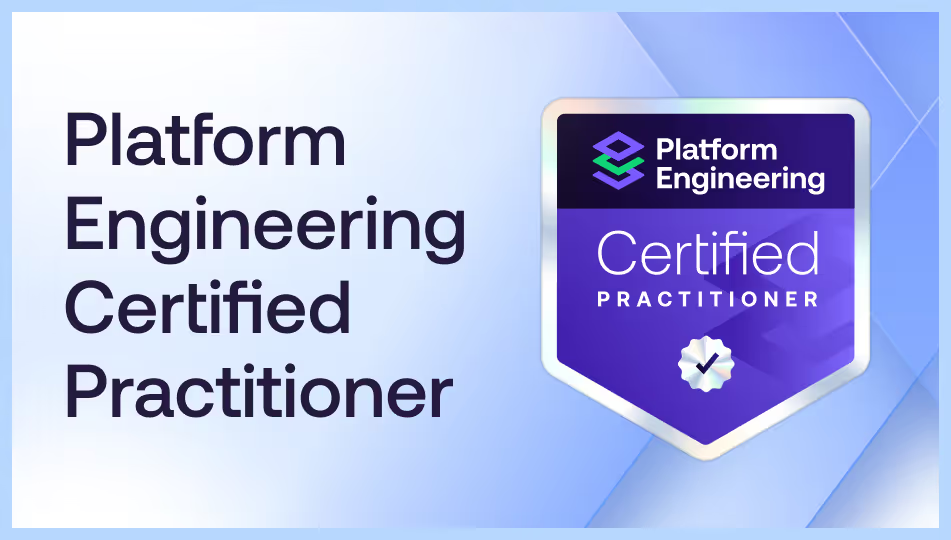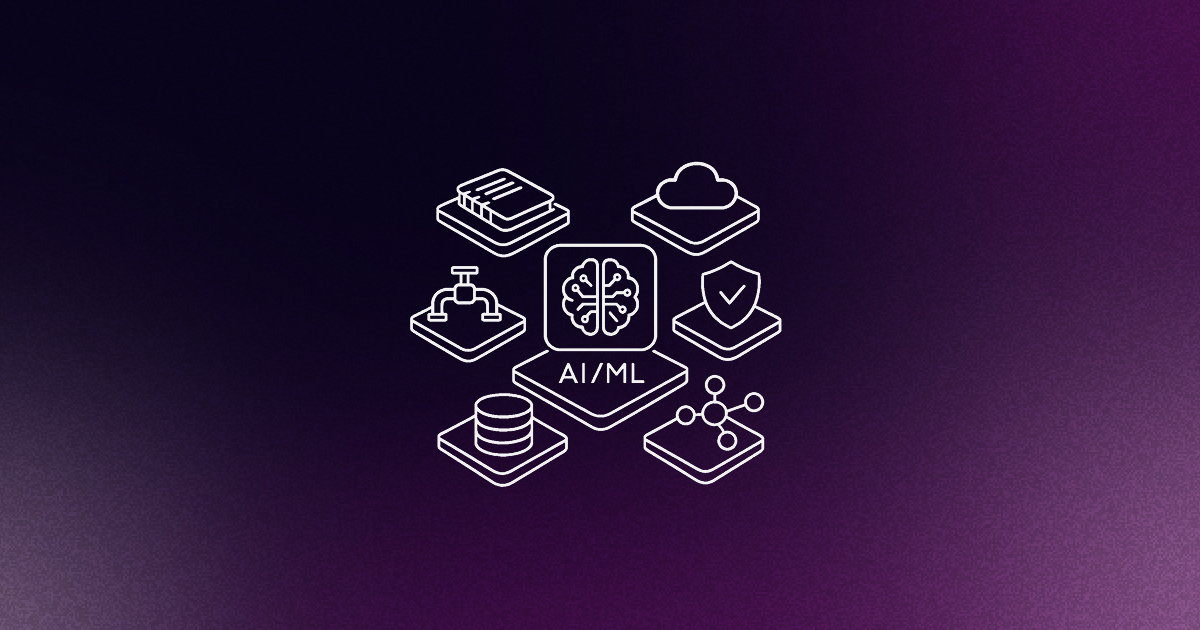You've decided to build an Internal Developer Platform. Now comes the hard part: actually implementing it without falling into the traps that derail most platform initiatives.
Here's the thing - most platform teams fail not because they lack technical skills, but because they either never get beyond planning, build something too large to prove value, or can't demonstrate ROI to stakeholders. The solution isn't more planning. It's a structured, MVP-first approach that proves value in weeks, not years.
This guide walks you through the four-phase framework that successful platform teams use to go from concept to working platform in eight weeks. You'll learn how to select your pioneering team strategically, implement developer self-service patterns that actually get used, and avoid the common pitfalls that kill platform adoption.
What you're actually building: Platform vs portal
Before you write a single line of infrastructure as code, understand this distinction: an Internal Developer Platform is not the same as an Internal Developer Portal.
Your IDP is the entire backend infrastructure layer - the orchestration engine, integrations, automation, and golden paths that enable developer self-service. A portal like Backstage is simply one possible interface sitting on top of that platform. As Gartner puts it: "Internal developer portals serve as the interface through which developers can discover and access internal developer platform capabilities."
Aaron Erickson from Salesforce uses a house-building analogy that makes this concrete: "Building an internal developer platform is like building a house. You should start from the foundations, the backend, then add walls with doors and windows (the frontend) later. To build a platform by starting with a portal is like building a house by starting with the front door."
This matters because the most common sequencing mistake platform teams make is building a portal first. You end up with a beautiful UI that doesn't actually do anything, or worse, you make architectural decisions based on portal constraints rather than your actual infrastructure needs.
Why start with a Minimum Viable Platform (MVP)
Platform initiatives fail in predictable ways. Teams spend months in planning cycles, try to build two-to-five-year roadmaps upfront, or can't prove value quickly enough to maintain stakeholder buy-in. The MVP approach mitigates these risks by forcing you to demonstrate value within eight weeks.
An effective MVP has four characteristics:
Representative: Your MVP includes basic resources and components common across your technical estate - think standard database types, basic CI/CD, typical application structures. Not every edge case, just the patterns that matter most.
Repeatable: The skeleton you build becomes a quickstart template for other teams. If your first application integration requires completely custom work that can't be reused, you've built a one-off solution, not a platform.
Iterative: You're building a foundation for growth, not a finished product. Every decision should account for how it scales, but you're not implementing that scale yet.
Innovative: Your pioneering team should feel inspired to learn new things and engage with new technologies. If your MVP just automates existing manual processes without improving them, you've missed an opportunity.
The MVP sits within a three-program sequence: MVP (8 weeks, demoable platform) → Production Readiness Program (8 weeks, first team using daily) → Adoption Program (large-scale rollout). This structure makes platform engineering predictable and outcome-focused.
The four-phase implementation framework
Your MVP runs across three parallel tracks - Technical, Business, and Security - each with specific deliverables per phase. This parallel structure ensures you're not just building technology; you're building organizational buy-in and security confidence simultaneously.
Phase 1: Discovery (weeks 1-2)
Technical track: Run an MVP objectives workshop to align on what you're building and why. Conduct technical discovery to understand which tools are already in use and what's missing. Design your target reference architecture and define the golden paths you'll start with.
Business track: Map your stakeholders and identify target outcomes for each group. Application developers need self-service at low cognitive load. Infrastructure teams need technical conviction that this is a vending machine layer for their infrastructure. Security needs confidence in the design. Executives need ROI justification. Gather baseline metrics now - you'll need them to prove value later.
Security track: Security requirements documentation and workshop facilitation
Phase 2: Integration (weeks 3-4)
Technical track: Integrate your platform tooling. Set up admin and RBAC. Connect to cloud providers. Deploy a sample application to validate your architecture. Create environments for non-production workloads and define resource templates.
Business track: Business case development with quantitative time-savings data
Security track: Security requirements gathering and initial compliance alignment
Phase 3: Deployment (weeks 5-6)
Technical track: First application integration, CI/CD pipeline setup, end-to-end testing
Business track: Finance team involvement and ROI presentation preparation
Security track: Security team collaboration and initial posture validation. Note that final production readiness confirmation occurs in Phase 4.
Phase 4: Adoption planning (weeks 7-8)
Technical track: First team onboarding, demo preparation, roadmap planning
Business track: ROI presentation to executives and success measurement
Security track: Production readiness security confirmation and green light
Selecting your pioneering team strategically
Your first team makes or breaks your MVP. Choose wrong and you'll spend months debugging edge cases that don't represent your broader technical estate. Choose right and you'll build momentum that carries through adoption.
Use the Force Ranking Template methodology to evaluate candidates systematically. Score potential teams across three dimensions:
- Business value: High-priority teams work on revenue-generating or strategically important applications. Their success matters to executives.
- Pain points: Teams experiencing significant friction in their current workflows will appreciate the platform's value immediately and become advocates.
- Application type: Greenfield applications demonstrate platform value better than legacy systems. You're proving the platform works, not solving the hardest migration problems.
Rank candidates as High, Medium, or Low Priority based on these criteria. Your pioneering team should be High Priority across all three dimensions.
Three principles guide successful onboarding:
Structured sequencing: Start with the software development cycle as your primary focus. Narrow in on the priority pieces for value generation. Gradually expand responsibilities rather than trying to solve everything at once.
Clear prioritization: Define what the platform will and won't handle early. Use your tech and onboarding roadmap to bring in new responsibilities systematically. Saying no to scope creep is how you finish in eight weeks.
Controlled onboarding: Cluster and queue applications systematically. You can't solve all problems at once, and trying to do so guarantees failure.
Implementing developer self-service patterns
Self-service is how developers actually use your platform. Get this wrong and you've built infrastructure that requires tickets and manual intervention - the opposite of what you're trying to achieve.
Your MVP self-service should be opinionated (paved road, not toolbox), simple (one command or PR equals deploy), secure (RBAC and guardrails built in), and observable (clear feedback loops and status information).
Three implementation patterns work for different organizational contexts:
Git-based approach: Developers submit a PR to a repository, which triggers deployment. Best for simple MVPs and infrastructure-heavy teams already comfortable with GitOps patterns. Minimal new tooling to learn.
CLI-based approach: Developers use a command-line tool (like humctl, Heroku CLI, or custom scripts) to interact with the platform. Optimal for mid-scale teams requiring fast iteration. Provides more flexibility than Git-based approaches without the complexity of a full portal.
Portal-based approach: Developers use a UI like Backstage to scaffold applications, request infrastructure, and view deployments. This is appropriate for large organizations with high complexity and diverse user populations. Don't build a portal just to have one - a good CLI plus documentation is often enough.
Common MVP self-service capabilities include new app scaffolding (reduces boilerplate), deployments (core developer feedback loop), and infrastructure provisioning (solves common pain points). Avoid advanced features like custom DNS or self-service RBAC management in your MVP - they're too specific and complex.
Reference implementations like CNOE (Backstage + Coder + Gitea + Terraform/Crossplane) and PocketIDP (Backstage + Score + Humanitec Platform Orchestrator + CLI) provide proven patterns you can adapt. Don't worry about having a perfect developer portal. Just unblock deploys and focus on your primary golden paths.
Measuring success and avoiding common pitfalls
Success metrics vary by stakeholder persona, but they all need concrete data.
Infrastructure and operations teams need technical conviction that the platform is a vending machine layer for their infrastructure, not additional operational burden. Show them reduced ticket volume and standardized patterns.
Application developers need proof that self-service actually works at low cognitive load. Measure time savings using your baseline metrics: adding services drops from 16 hours to 8 hours, onboarding drops from 80 hours to 16 hours. These are illustrative examples - substitute your own measured baselines from Phase 1.
Security teams need confidence in the design. Show them how guardrails are enforced by default, how RBAC prevents unauthorized access, and how the platform improves security posture rather than creating new risks.
Executives need ROI justification. Translate time savings into cost savings. If you're saving 64 hours per developer per quarter across 50 developers, that's 3,200 hours - roughly 1.5 full-time engineers worth of productivity gained (assuming approximately 2,000 hours per FTE-year).
Common failure modes to avoid:
Scope creep: You start with a simple MVP and gradually add "just one more feature" until you're three months in with nothing demoable. Stick to your Phase 1 scope definition ruthlessly.
Portal-first trap: Building a beautiful UI before the backend works. Remember the house analogy - foundations first, front door later.
Stakeholder expectation management: Promising too much too soon. Your MVP proves the concept; it doesn't solve every problem. Set expectations clearly in Phase 1 and reinforce them throughout.
Brownfield integration challenges: Existing toolchains and legacy systems create integration complexity. Don't try to migrate everything in your MVP. Pick one representative application and prove the pattern works.
Scaling beyond your MVP
Your MVP proves the concept. The Production Readiness Program makes it production-grade. The Adoption Program scales it across your organization.
Transition planning starts in Phase 4 when you build your roadmap. Identify which capabilities need hardening (observability, disaster recovery, advanced RBAC), which teams onboard next (use your Force Ranking Template), and what skills your platform team needs to add (more DevEx focus, product management, technical writing).
Team scaling follows a pattern: start with standardization experts (IaC tools, pipeline standardization, cloud provider knowledge), add automation experts (pipeline design, developer experience, documentation), then bring in product management to treat the platform as a product with a roadmap and user research.
For comprehensive learning on platform engineering practices, methodologies, and advanced implementation patterns, explore Platform Engineering University. It provides structured training that goes beyond MVP implementation into production-grade platform operations and organizational transformation.
Frequently asked questions
How long does it take to build a production-ready IDP?
Eight weeks for MVP, eight weeks for Production Readiness Program, then ongoing adoption. Total time to first production grade deployments: 16 weeks.
Should we build or buy our platform tooling?
Start with proven tools and reference implementations. Build custom integrations only where necessary - Don't reinvent orchestration or CI/CD!
What if our first team's application doesn't represent our technical estate?
Choose a different team. Your MVP must be representative or you'll build the wrong thing. Use the Force Ranking Template to evaluate alternatives. When you realize a first team won’t fit your MVP goals, you need to pivot quickly.
Do we need a developer portal for our MVP?
No. A good CLI plus documentation is often enough! Build the backend first, and add a portal later if adoption data shows it's needed.
What's the typical budget required for an IDP?
Budget varies significantly based on organization size and existing infrastructure. For an MVP, focus on engineering time (typically 2-4 full-time engineers for 8 weeks) plus tooling costs. Most successful MVPs leverage open-source tools or tools already within the team’s stack to minimize licensing costs during the proof-of-concept phase.
Join the Platform Engineering community and connect with peers on Slack.











